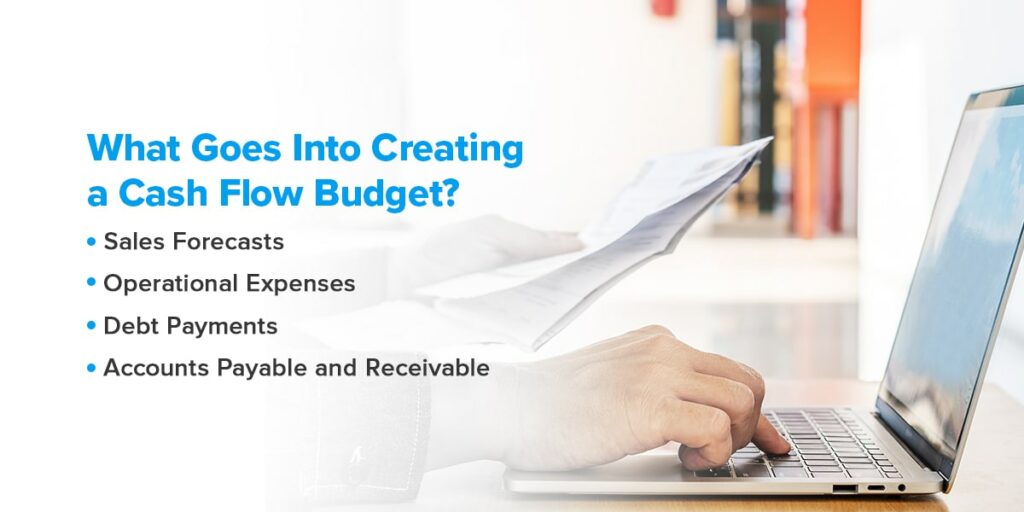Businesses can experience several cash flow issues, from poor bookkeeping to buying too much inventory. A lack of a cash flow budget is a significant problem that can leave companies unsure of how much money is entering and leaving their accounts each week.
When your company creates a cash flow budget, it is empowered to plan for the future, ensure it can meet expenses and make more informed financial decisions regarding its income streams. Creating an effective cash flow budget puts your business on the path to greater knowledge of its finances.
What Is a Cash Flow Budget?
A cash flow budget is an assessment of a business’ cash inflows and outflows, along with a plan for paying its debts and other obligations. Managing funds is crucial to a business’ success and growth, and a cash flow budget is a valuable tool for accomplishing that goal. A cash flow budget is a forecast of a company’s income and expenses and changes based on financial circumstances. Cash flow budgeting involves assessing your business’ finances and estimating future cash flow rather than calculating a specific number.
A cash flow plan, as this budget is also called, projects cash flow over a specific accounting period, such as a month, quarter or year. The budget is a guide for businesses to assess the liquidity of their money. A cash flow budget doesn’t necessarily measure a company’s profitability but examines the movement of funds and provides a roadmap for determining whether the business can continue its daily operations.
Nearly every aspect of operating your business requires funds, from completing payroll to paying rent and buying supplies. Keeping tabs on your business’ income and expenses through a cash flow budget helps your company ensure it can pay its expenses.

What Goes Into Creating a Cash Flow Budget?
A cash flow budget may include several different elements. Here are some of the important figures business owners should have in their cash flow budgets:
1. Sales Forecasts
The data you include in your cash flow budget should include all your business’ cash inflows and outflows. Sales forecasts are a critical category of business income. Sales forecasts estimate the income you can expect over the period your cash flow budget covers.
To estimate your sales income for the period of your cash flow plan, multiply the number of sales units or customers you expect during the weekly, monthly or quarterly period by the cost of those units. Include every income avenue in this calculation, including all goods and services.
2. Operational Expenses
Your business’ operational expenses are an essential type of cash outflow. Knowing when you need to pay your expenses helps you budget for them. Subtract your operational expenses from the cash inflow you’ve already tracked.
The operational expenses you include in your cash flow budget may vary depending on the period you’ve chosen for your budget to cover. For example, a short-term cash flow budget that only focuses on a single month should include expenses like payroll, rent, utility bills and other investments. A long-term cash flow plan that covers an entire year might include long-term investments and capital expenditure on buildings or equipment.
3. Debt Payments
Include your business loan payments in your cash flow budget. Paying your debts is vital for maintaining your company’s financial health. The timing of these expenses may vary, so a weekly cash flow plan may not include any debt payments. However, taking these payments into account is essential for getting an accurate picture of your cash outflow.
To calculate your business’ debt payments within a weekly, monthly or quarterly period, determine how much you pay toward any loans during the period. Include loans like a mortgage, business taxes and any other debt.
4. Accounts Payable and Receivable
Your company’s accounts payable and accounts receivable are crucial elements in cash flow forecasting. Accounts payable lists your short-term obligations for goods purchased from suppliers or services rendered from contractors. Accounts receivable outlines the income you can expect from your customers and partners. Both of these amounts contribute to the movement of money into and out of your accounts. Subtract accounts payable and add accounts receivable to the other figures in your cash flow budget.
How To Use the Cash Flow Margin Calculator
- Fill in net income.
- Fill in depreciation and amortization.
- Fill in the increase in net working capital.
- Fill in sales revenue amount.
- Press Calculate.
Benefits of a Cash Flow Budget Plan
Cash flow forecasting offers several benefits to your business, whatever your industry. While a cash flow budget may differ based on your company’s needs, income and expenses, it’s always a helpful financial tool. Check out these benefits of a cash flow plan:
Prepares Your Business for Fluctuations
Cash flow sometimes fluctuates due to seasonality or unexpected growth. Developing a cash flow plan several months before the budget’s period helps you forecast and prepare for any cash inflow and outflow fluctuations. For example, your business may need to invest more in capital assets during a specific period, tying up some of its cash in a building or other physical property. If a cash flow budget indicates that cash gaps are approaching, your company can decide how best to use its income.
Keeps You Paying Your Bills on Time
Large and infrequent expenditures like software subscription renewals can become lost among other budget items. A cash flow budget enables prompt and timely bill payment by helping your business prepare for upcoming expenses. When you create a cash flow plan, you document when each bill requires payment, giving your team greater insight into your company’s costs so they can prepare accordingly.
Helps You Manage Surplus Cash
Excess cash can be helpful for further growth if used thoughtfully. A cash flow budget empowers your company’s financial team to make more informed financial decisions. When your business uses a cash flow plan, it develops a plan for allocating surplus cash appropriately to help it meet its goals.
If the financial team notices an upcoming cash flow gap, a surplus may be best spent preparing for the upcoming need. Alternatively, executives may use excess cash to increase the marketing budget or provide employees with a raise. A cash flow budget helps you determine the best use of the extra funds.
Plans for Future Business Growth
One of the greatest advantages of cash flow forecasting is how it helps your business plan for future growth. A cash flow budget provides your company with insight into its spending and progress toward revenue goals. Cash flow budgeting also gives your team the insight to model future scenarios and see how different situations might affect your cash flow. This tool helps your financial team see the real impact of your budgeting, make more informed plans and take strides into the future.
Keeps Track of Cash Flow Plans
Cash flow forecasting also offers better insight into your business’ financial trends. The budget highlights any spending tendencies or sales surges that happen throughout the year, which can help your teams capitalize on opportunities or find solutions to challenges. Tracking your cash flow budget can potentially help you increase sales and profits by providing an outline of your company’s finances.
Let Porter Capital Help You Improve Your Cash Flow
Managing your cash flow is critical to your business success, and a cash flow budget helps spot trends in your income and expenses. If your company is experiencing a cash flow gap, Porter Capital can help. Porter Capital offers funding for all the ways you do business. We provide invoice and accounts receivable factoring to help increase your business’ cash flow.
Our application process is easy and fast, with no hidden fees or terms, and we can provide funding in as little as 24 hours. Contact Porter Capital today to learn more about how we can help your business improve its cash flow.




